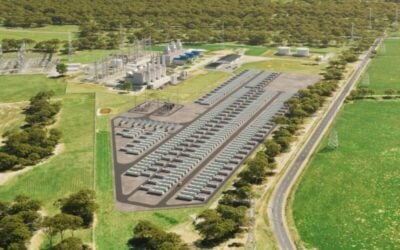The UK’s Big Battery, a large-scale trial project. Image: S&C Electric.
Although Britain’s government has cut support for renewable energy severely in the past few months, controversially claiming a need to balance the transition away from fossil fuels against the cost to consumers, energy storage may face less of a challenge at the top level, according speakers at a conference in London.
Speakers and members of the audience at a UK Renewable Energy Association event held yesterday said that with a properly designed marketplace and continuing cost reductions, feed-in tariffs or similar support schemes would not be necessary to enable energy storage technologies to succeed.
Enjoy 12 months of exclusive analysis
- Regular insight and analysis of the industry’s biggest developments
- In-depth interviews with the industry’s leading figures
- Annual digital subscription to the PV Tech Power journal
- Discounts on Solar Media’s portfolio of events, in-person and virtual
Many of the applications of energy storage, such as providing grid services and managing peak demand, could result in significant cost savings across the electricity network. According to some including a former advisor to the Department of Energy and Climate Change (DECC), this could be an antidote to tough government rhetoric which had led to FiTs for solar energy being slashed by around 65% in a policy review at the end of the year.
Simon Virley, partner at a branch of consultancy, KPMG, highlighted that the industry has only about two weeks to submit suggestions for a DECC consultation on energy innovation and “urged them” to do so. Results of that consultation will be published in spring.
Former government employee admits success of solar ‘took them completely by surprise’
Virley was formerly in an advisory role at DECC. Speaking in a panel discussion on decentralised energy at the REA’s event. ‘Energy storage: the new market dynamic’, Virley admitted that he had “sat in DECC while we were overtaken by global developments” in solar energy as China entered the solar market with dramatic consequences.
Keeping pace with global technological developments was a “hell of a challenge” for DECC, Virley said. Having been taken by complete surprise by the success of solar during his tenure at DECC over the past five years, Virley said, he expected energy storage to be a “game changer” in the same way for the next five.
“In these cash-strapped times, I think it’s important to say to ministers, to say to politicians, this isn’t about money, this is about now removing regulatory barriers, it’s about allowing the private sector to develop propositions to consumers and households that make sense in commercial terms. DECC does not have all the answers – I cannot stress that enough.”
The panel’s chair, REA CEO Nina Skorupska, asked later if there was an appetite for storage at government level, to which Virley replied that in his opinion “lower bills mean they have to take it seriously”. Energy Storage News has also heard that at grid and regulatory level there is an appetite to enable flexibility in the network, with energy storage a key component.
However, despite strong rhetoric at the recent COP21 talks, the Conservative-led government has made decisions on energy policy that include a plan to build a new nuclear generation facilities thought to be twice as expensive as others and a seeming obsession with the economic benefits of fracking for shale.
Politician Angus McNeil of the Scottish National Party, appointed chair of the energy and climate change committee, an independent group of MPs that holds the government to account said jokingly in an address from the stage that the short-term approach of the government was like “a farmer who in winter thinks it’s a waste of money to invest in seeds”.
The event was also marked by the appearance of a representative from the National Infrastructure Commission, a new cross-party agency set up with a reported budget of £100 billion across all sectors. While the NIC’s head, government minister Andrew Adonis, did not make a planned appearance as keynote speaker, Phil Graham from the NIC participated in the decentralisation panel. Graham was noncommittal for the most part but agreed that if storage could show “tangible benefits”, that would drive its cause forward more quickly.
UK secretary of state for energy and climate change, Amber Rudd, visits the Big Battery. Image: Younicos.
Defining the technology and market boundaries
Regulatory barriers in the UK facing storage which Energy Storage News and others have reported include a lack of satisfactory definition of the technology, which is only recognised by network operators as a generato even though it can be generator and load as well as potentially being part of transmission and distribution infrastructurer.
Experts also suggest that establishing an asset class for the technology would allow it to participate in the energy market, helping it to provide returns on investment.
So far the UK has seen projects installed on a trial or demonstration basis not only to demonstrate technological capabilities of systems but also serve as examples of services they can provide and business models they could operate under.
One major difference between predictions on possible market size from analysis firm, Eunomia, which has said Britain could have 1.6GW of storage installed by 2020, and the more conservative estimates of another, IHS, which put it closer to 1GW, is that Eunomia’s reporting plays up potential in the commercial and industrial sector. The UK currently has far more stringent time-of-day and peak electricity pricing for heavy users of electricity, which storage could mitigate. Going forward, the government is committed to a nationwide rollout of smart metering, which could enable better visibility into half-hourly pricing windows for other sectors, including residential.
The UK is also preparing its first frequency regulation tender through its network operator, National Grid, offering 20MW of capacity. The panel discussion participants also included Rob Sauven of Renewable Energy Systems, which has developed around 70MW of frequency regulation projects in the US.






